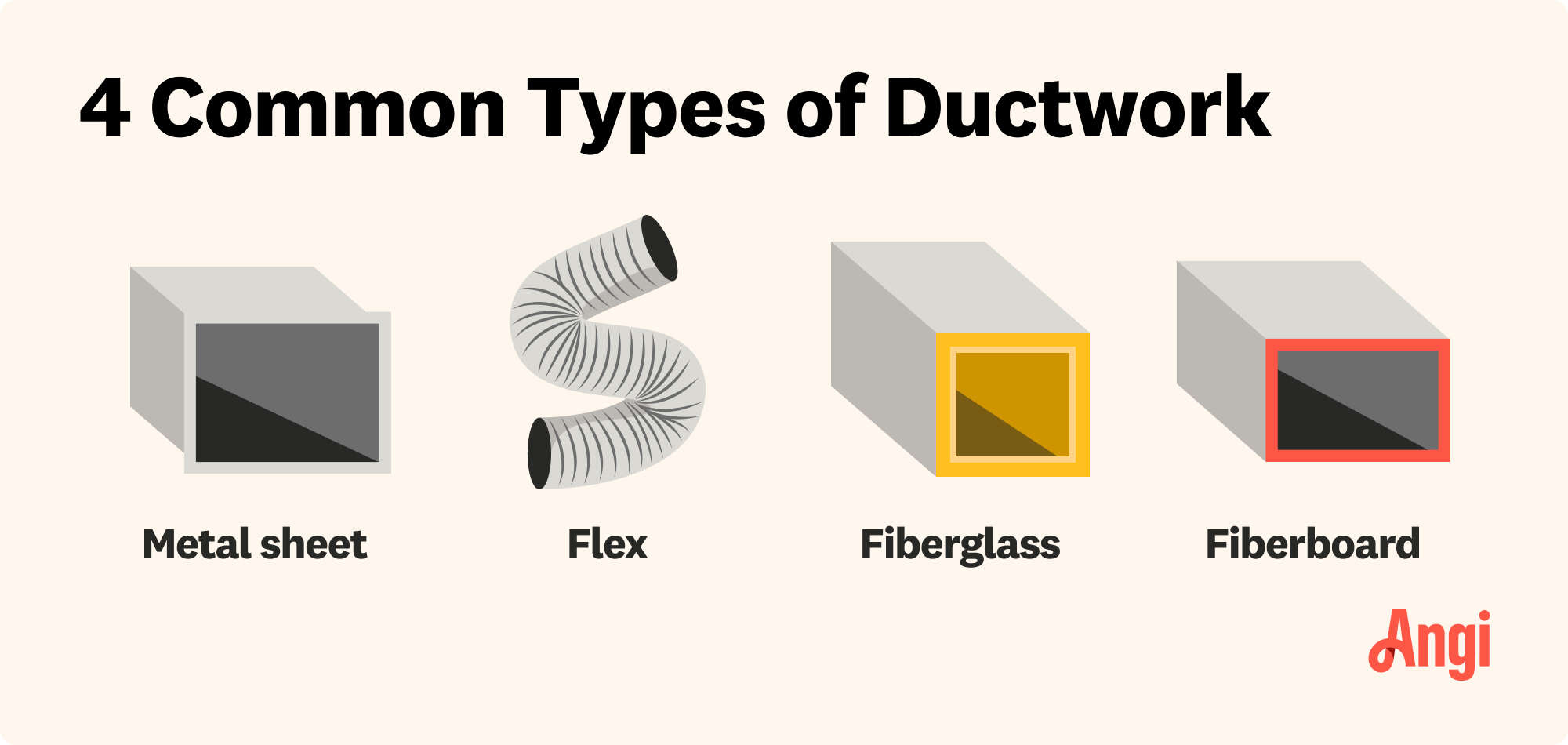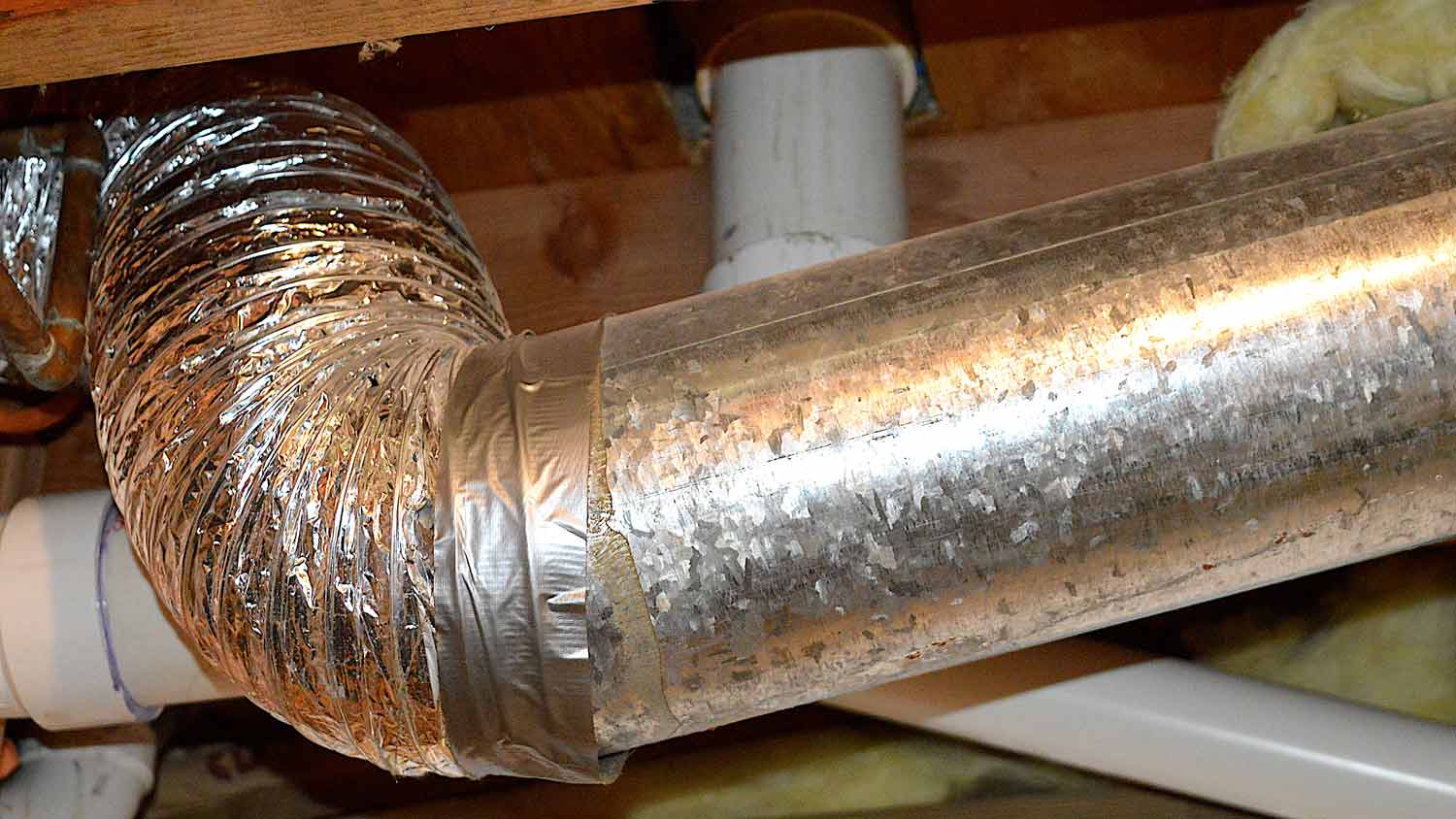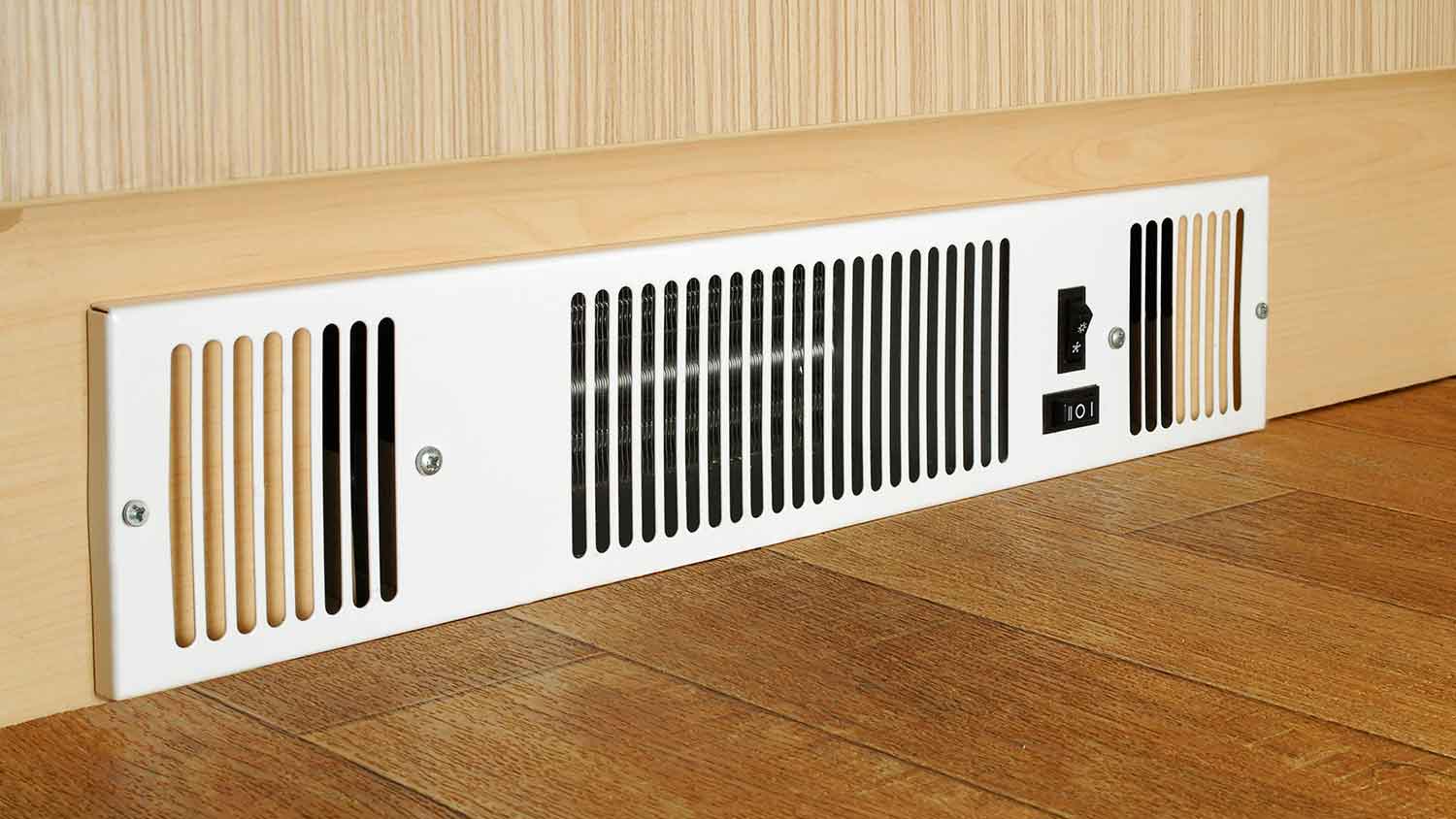Flex Duct vs. Rigid Duct: Pros, Cons, and Costs
Get your ducts in a row


Both flexible and rigid ducts distribute air throughout your home.
Flex ducts are less durable but more cost-effective and easier to install.
Rigid ducts are long-lasting but can be trickier to install due to their inflexibility and weight.
You have ductwork to thank for distributing air throughout your home and keeping a comfortable temperature year-round. If you're considering upgrading or installing your home's HVAC system, you need to choose between different types of ductwork: flex or rigid. Learn how these two duct types compare so you can choose the one that works for you.
Flex Duct vs. Rigid: Key Differences

Flexible ductwork can be made from silicone, rubber, plastic, or plastic-coated fabric, while rigid ducts are made from aluminum or steel. While flexible ducts can change size to fit a particular area, rigid ducts are always the same size and may be shaped like tubes or rectangles.
Other key differences between flex and rigid ducts include their price, ease of installation, and longevity.
What Are Flex Ducts?

Flex ducts are lightweight and tube-shaped with an accordion-like structure that can bend and twist around objects, giving them a lot of versatility on where you can use them. Typically, they have three components: the wire coiling, insulation, and the covering. The covering on a flex duct is commonly made of aluminum but can be made out of a number of materials ranging from plastic, silicone, or fabric.
Flex ducts can come with or without insulation. Insulated flex ducts can regulate heat loss or gain, whereas uninsulated ducts are better for homes in regulated climates where drastic temperatures don’t occur.
| Pros | Cons |
|---|---|
| Lower cost | Require support |
| Easy installation | Shorter longevity |
| Fit into tight spots | Reduced efficiency |
Best for:
Homes with lots of tight areas
Budget-conscious homeowners
Pros of Flexible Ducts
One of the biggest benefits of flexible ductwork is its lower cost than rigid ducts. Thanks to their light weight and malleability, they are also much easier to install. You can install flexible ductwork in places that are too small or oddly shaped for rigid ducts.
Cons of Flexible Ducts
Flexible ductwork's malleability can sometimes work against it. The ducts require some form of support to prevent sagging. Since they aren't as smooth on the inside as rigid ducts, they may not be as energy efficient.
The biggest drawback to flexible ductwork is that they don't last nearly as long as rigid ducts. Their flexibility can make them more prone to snags and tears.
What Is Rigid Ductwork?

Rigid ductwork is made from a more structurally sound material but is less forgiving during the installation process. The most common type of rigid duct is galvanized steel (also known as steel ducts), but other materials include aluminum, fiberglass, and fiberboard.
Rigid ducts come in three shapes: rectangular, round, and ovular. In recent years, semi-rigid ducts have come into the market, offering more installation flexibility and cutting down on some of the labor costs.
| Pros | Cons |
|---|---|
| Longevity | Higher cost |
| Greater efficiency | Complicated installation |
| Easy cleaning | Requires precision |
Best for:
Homes in areas that see extremely hot or cold temperatures
Pros of Rigid Ductwork
Whether made of aluminum or steel, rigid ductwork is built to last. Unlike flexible ducts, it won't snag, tear, or kink. Since the inside of the ducts is completely smooth, air can flow through them more efficiently, leading to lower energy bills. The ducts are also easier to clean compared to flexible options.
Cons of Rigid Ductwork
The big drawback of rigid ductwork is its price. It costs much more to install rigid ductwork than flexible ducts, and rigid duct replacement costs are also higher due to the complexity of installation.
Rigid ductwork weighs a lot, so it requires more people during installation. A local professional duct installer will also have to cut rigid ductwork to an exact length and ensure that the width of the ducts works in the space.
Flex Ducts vs. Rigid Ducts
Here's how flex ducts and rigid ducts stack up.
Durability: Rigid Ducts
Rigid ducts win hands down when it comes to durability. Thanks to their sturdy metal material, they resist rust and mold growth and can last for decades.
Price: Flex Ducts
While rigid ducts win for durability, flexible ducts give them a run for their money. Flex ducts are more affordable, ranging from $1 to $4 per linear foot versus $7 to $13 per linear foot for metal.
Since they have a simpler installation process, the cost to install or replace flexible ducts is also lower than for rigid ducts.
Noise: Tie
Both rigid and flex ducts can make noise while they work. While the shape of rigid ducts can help them direct sound more smoothly and dampen the hum of airflow, you may hear noise if they become blocked or turn at certain angles.
Flex ducts may also produce noise due to their walls' ability to contract and expand in response to changes in temperature and air pressure. However, flex ducts can also reduce noise if they're made of non-metal materials such as fiberboard or if they're installed at the end of the ductwork system.
All ducts generate noise, but some sounds are cause for concern. A gentle humming or clicking is normal, but loud rattling, banging, buzzing, or whistling means you may have a problem requiring professional help. Some factors that cause excessively noisy ducts include dents or damage, loose metal parts, dirty or blocked vents, and closed dampers.
Ease of Installation/DIYability: Flex Ducts
Once again, flex duct wins for installation ease. The ductwork weighs less, which makes it easier to maneuver. It's also more forgiving in tight areas. Because you can scrunch it, there's more leeway when cutting the ductwork, too.
Maintenance: Rigid Ducts
Rigid ducts are easier to clean than flex ducts, as dirt and debris are less likely to get trapped inside them. Since they resist rust and mold growth, you don't have to worry as much about cutting the ductwork in place to replace sections of it.
Flex ducts require more frequent cleanings than rigid ducts, to keep dust and debris from collecting inside.
Energy Efficiency: Rigid Ducts
Thanks to the smooth interior surface, air flows easily through rigid ducts, which can help your HVAC heat or cool your home more efficiently. While flex ducts can still heat and cool your home, they do so with slightly less efficiency, thanks to the uneven texture inside.
How Much Does It Cost to Install Air Ducts?
The cost to replace air ducts ranges from $455 to $2,185, with the average person paying $1,250. If you’re starting your duct framework from scratch, costs depend heavily on the type and installation method. The cheapest option is exposed ductwork, which costs between $1,600 and $4,800 or an average of $2,200.
The price you pay will depend on your home’s size, the condition of your interior walls, which types of ducts you choose, and any repairs needed.
DIY vs. Hiring a Pro
While it may save you some money, installing air ducts yourself isn’t recommended unless you’re an extremely skilled DIYer. The labor costs associated with this project can range anywhere from $2,000 to $5,000, depending on the professional and the job scope. However, a lot can go wrong if you install air ducts yourself improperly, such as leaks, HVAC damage, poor energy efficiency, and insurance issues. Ultimately, it’s not worth the price of your time or the risk to do it yourself, so hire a local air duct professional for the job.
Frequently Asked Questions
Whether rigid or flexible ducts are better depends on your needs. If you need to work around any space or budget constraints, a flex duct makes the most sense. But if you want something that will last and don’t mind spending the extra cash, a rigid air duct is better long term.
Rigid ducts are easier to clean and can withstand any moisture the bathroom may create, but they are more costly and can’t be easily moved. Flex ducts are a great solution if you don’t have much space and want flexibility in where you place your duct, but they’re more difficult to clean, need a lot of support, and aren’t as sturdy as rigid ducts.
When first installed, flex ducts shouldn’t cause airflow problems in your home. However, because flex ducts aren’t the sturdiest and require extra support, they lose their durability over time and begin to sag, which can inhibit airflow down the road. Also, if your flex ducts aren’t tight enough, your HVAC could work twice as hard for the same air pressure. If you’re worried about the airflow in your home, a rigid duct may be your best bet.





- Furnace Repair
- Air Conditioning Repair
- HVAC Repairs
- Furnace Installation
- Wood & Pellet Stove Repair
- Dehumidifier & Humidifier Repair
- Heat Pump Companies
- Swamp Cooler Repair
- Wood Stove Services
- HVAC Companies
- Commercial A/C Repair
- Geothermal Installation
- Air Conditioning Installation
- Boiler Repair
- 24 Hour Furnace Repair
- Geothermal Repair
- Heat Pump Repair
- Humidifier Installation
- Thermostat Repair
- Thermostat Installation
- Nest Installation
- Heating & Cooling
- Heating Repair
- Furnace Cleaning
- Furnace Tune-Up
- HVAC Technicians
- Subcontractors
- Furnace Maintenance
- Plumbing & Heating Companies
- Wood Stove Inspection
- Mini Split Installation
- Wall Heater Repair
- Duct Installers
- Can You Use Flexible Ducts for Your HVAC System? Pros and Cons to Consider
- 4 Types of Ductwork and How to Choose One
- What Are Air Ducts? Understanding Your Home’s Ductwork
- When Is Insulation Required on Air Ducts? What You Need to Know
- What Is the Best Ductwork for Crawl Spaces?
- Can Dirty Air Ducts Make You Sick? Here's What You Need to Know
- Why Does My Ductwork Make Banging Noises?
- How Long Does Air Duct Cleaning Take? 4 Factors That Impact the Time Frame
- Why Your Ductwork Is Popping When Your Furnace Turns Off (And How to Fix It)
- 11 Common Signs of Dirty Air Ducts and What to Do Next











